From 5,000 to 15,000 Blog Views In 8 Months: The B2B Blog Strategy


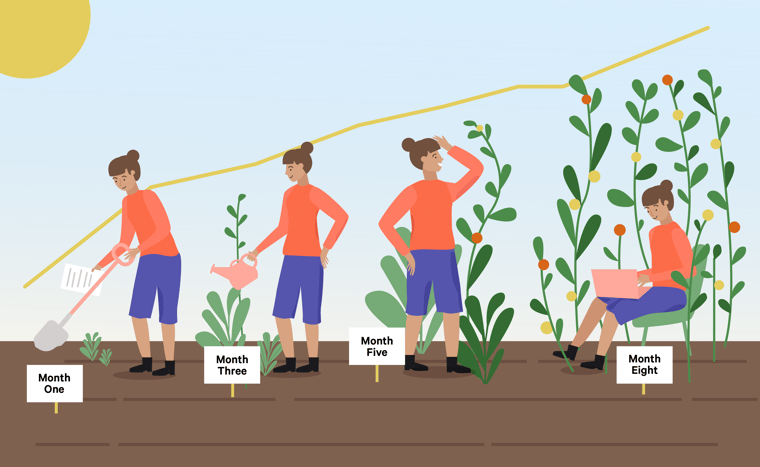 Disclosure: We only discuss products we use here at Nectafy. Some of the links in this article are affiliate links that may provide Nectafy with a small commission at no cost to you.
Disclosure: We only discuss products we use here at Nectafy. Some of the links in this article are affiliate links that may provide Nectafy with a small commission at no cost to you.
In our experience, most companies that put in the effort to do growth content (content that helps drive business growth) follow a very similar pattern:
- Slow start: During the first few months (anywhere from three to nine months), they are consistently creating and posting good content, but Google just doesn’t care yet.
- Rapid growth: After a few months, they experience a period of rapid growth, where the work from the previous months and new, ongoing work all blossom at the same time.
Today, we’ll take a look at a real Nectafy client, Genesis HR Solutions, that followed that exact pattern, going from under 5,000 blog views pre-growth content to over 15,000 in just eight months. Here’s how it happened.
- Slow start: From month zero to month six, blog views grew from 3,599 to 4,938. That’s a 38% increase.
- Rapid growth: From month six to month 14, blog views grew from 4,983 views to 15,766. That’s a 216% increase.
We’re going to zoom in on that rapid growth period today. What happens during that time? What are the main drivers of growth? Which content strategies paid off?
From 5,000 to 15,000 Blog Views In 8 Months
The Results
In the table below, you’ll see the important metrics over the two beginning periods, slow start (month 0-6) and rapid growth (6-14).
|
Page 1 Keywords |
Page 1 Search Volume |
Avg Keyword Difficulty |
Blog Views |
|
|
Slow start Month 0 → 6 |
185 → 203 |
32,260 → 25,750 |
67 → 63 |
3,599 → 4,983 |
|
Rapid growth Month 6 → 14 |
203 → 502 |
25,750 → 54,210 |
63 → 64 |
4,983 → 15,766 |
Here are descriptions of the metrics:
- Page 1 keywords: The number of search phrases this website appeared for on Google’s first page of results.
- Page 1 search volume: The total amount of monthly searches that this website appeared for on Google’s first page of results (i.e. 185 keywords were searched 32,260 times total within an average month).
- Average keyword difficulty: An SEMRush measure of how hard it is to rank for a given keyword. This is the average difficulty score for all keywords appearing on Google’s first page.
- Blog views: The number of blog pageviews within the month.
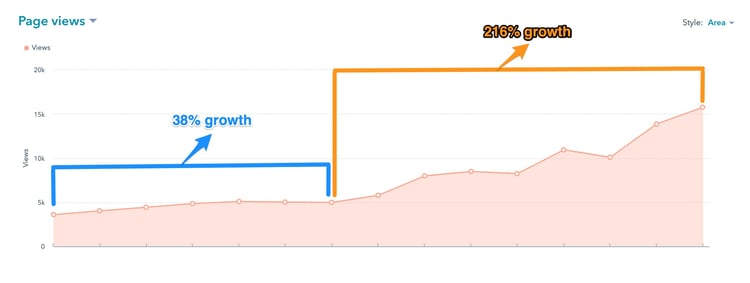
See Also: From 600 to 6,000 Organic Visits In 12 Months
The Strategy: How Your B2B Company Can Get These Results
1. Search for and pursue unicorn keywords.
Unicorn keywords are ones that are high in monthly search volume (lots of people are interested) and low in keyword difficulty (easier to rank for).
- A “high” monthly search volume is subjective depending on the website and industry. But I’d broadly say that any keyword searched over 1,000 times per month is high.
- SEMRush notes that keyword difficulty is considered low under 60/100.
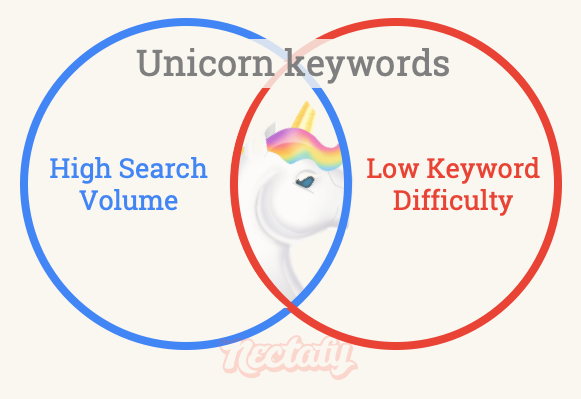
I’ve participated in the growth of over 50 B2B business blogs at this point in my career. For all of them that see meaningful growth, there is at least one uber-successful blog post built on unicorn keywords. These posts typically drive at least a quarter of the blog’s monthly traffic, secure hundreds of keyword rankings, and attract a number of helpful links.
How it worked for Genesis.
The blog post targeting unicorn keywords went from 308 views to 5,457 views over the eight-month period.
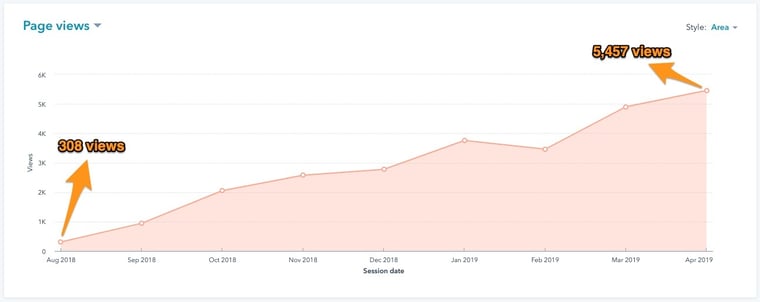
The post targeted a keyword group around “employee benefits” and brought in even better results than we planned on.
- We targeted four keywords (“types of employee benefits” and three closely related supporting keywords), but ended up ranking for 114 keywords on page one of Google.
- The group we targeted had 1,300 searches per month, but we ended up with exposure to 8,860 monthly searches on page one.
How it can work for you.
- Start by understanding your persona first. That should lead your keyword research.
- Then, filter your keyword list for a keyword difficulty under 60 (you need SEMRush for this).
- Then, sort your monthly search volume from most to least. The opportunities at the top are your potential unicorn keywords.
- Pick a top unicorn keyword to target, then search for related keywords in a keyword tool. Those related keywords can become your supporting keywords to target.
- Finally, write a long-form post to shift your odds positively in your favor. I’d recommend 1,200 words at minimum.
2. Build on any rankings you get by writing about related topics.
If you have keywords ranking for one topic, you’re much more likely to rank for similar topics. As a result, your first keyword ranking on a new topic is the beginning of your opportunity, not the end.
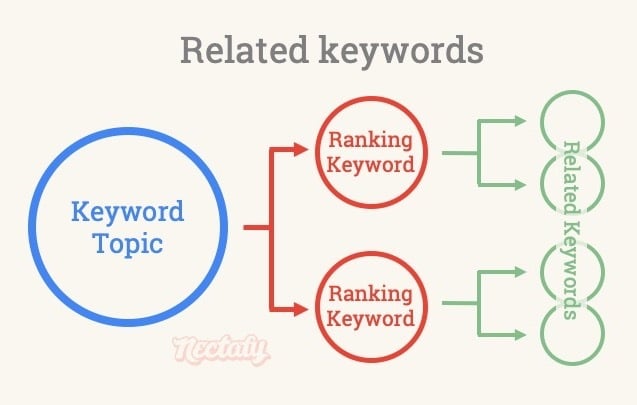
How it worked for Genesis.
- We targeted a group of keywords around “paternity leave in the US.” We got a ranking on page one for that main keyword—and 50 supporting ones. The blog post went from 130 views at the beginning of the rapid growth period to 864 by the end.
- After seeing that, we targeted “paternity leave in Massachusetts” (the geographical area Genesis targets). The blog post went from zero views at the beginning of the rapid growth period to 754 by the end.
- Finally, we targeted “maternity leave in Massachusetts.” The blog post went from zero views at the beginning of the rapid growth period to 511 by the end.
The first post, by itself, added over 700 blog views per month, which is nice. But the three posts together added over 2,000. That’s a multiplier.
How it can work for you.
- Track and report on your keyword rankings as part of the content planning process. What you see in the reporting should indicate the direction of your content calendar.
- Zoom in on your page-one rankings specifically. What topics are you ranking for?
- In your next content planning cycle, search those topics to find other keywords you don’t rank for. Those should go on your plan.
Zooming Out
This is a pretty typical first year for B2B clients we work with at Nectafy. If you can make it past the first few months of low or no growth, results start to pour in exponentially.
B2B content strategy is systematic and scientific. You have to find the right opportunities for your website within the data.
For Genesis, the two biggest drivers of success came from this systematic approach. First, we were able to find and rank for a group of unicorn keywords. That brought in an additional 5,000 blog views per month to one post. That process should be your biggest priority for a B2B blog.
Then, once some keyword rankings started to come in, we put a focus on finding related keywords. That amplified our early rankings and brought in 2,000 additional views per month.
If you find this article useful and want to start growth content for your company, there are two ways to go:
- If you want to try this out for your next post, play around with an SEMRush free trial. We do all of this research through that tool.
- To get all the highest-impact strategies started in the first three months read this: How To Generate Meaningful Organic Traffic To Your Website In 90 Days.
Or, talk to Lance about your goals. He can point you in the right direction.

